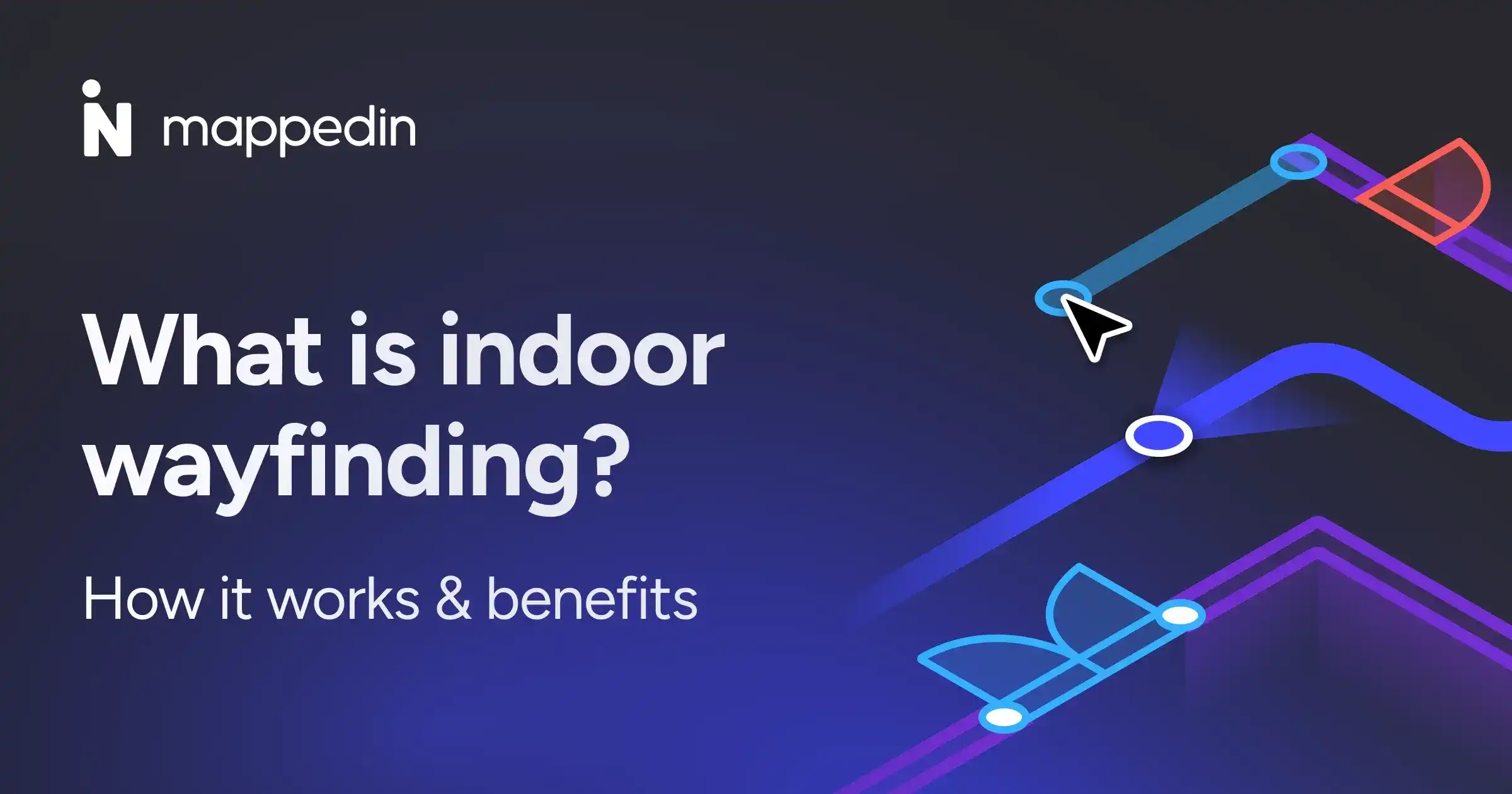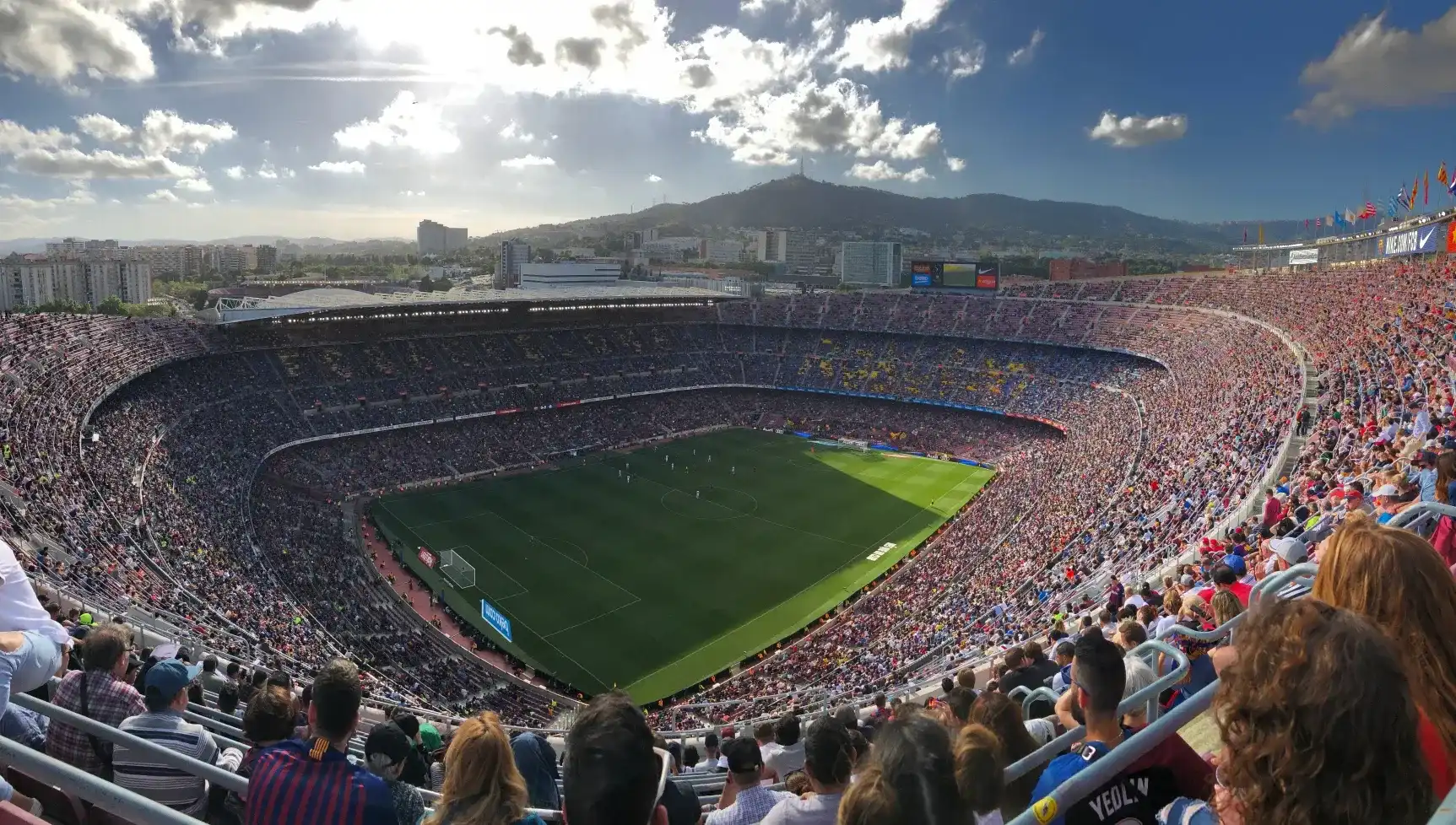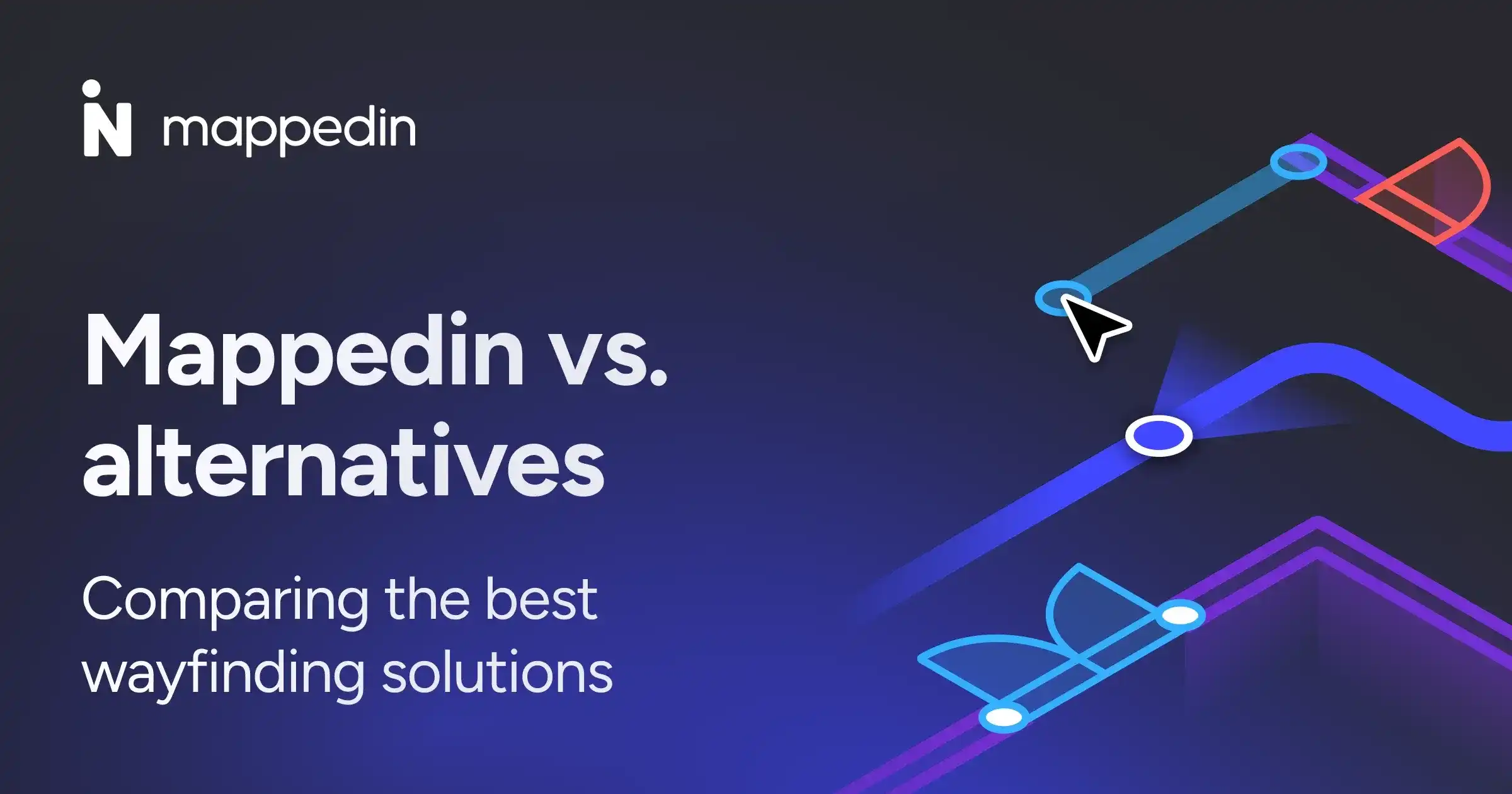Indoor spaces are growing more complex, and expectations for seamless navigation are higher than ever. As a trusted partner in indoor mapping—having powered 45,000+ maps around the world (and counting)—we've seen how digital wayfinding transforms the way people move through complex indoor venues including airports, offices, malls, hospitals, stadiums, and college campuses. And it's becoming more than just a nice-to-have; an easy-to-use, intuitive and intelligent digital wayfinding tool is now becoming table stakes for modern businesses and institutions:
— James Killick, Product @ Apple Maps, Ersi, MapQuest
In this guide, we’ll break down what indoor digital wayfinding is, how it works, where it delivers the most value, and how you can implement it successfully.
What is indoor digital wayfinding?
Indoor digital wayfinding is the use of digital maps, interactive signage, and navigation software to help people find their way inside complex venues. Unlike traditional static signs or printed directories, digital wayfinding leverages real-time data, mobile devices, and indoor positioning systems to deliver accurate, step-by-step guidance. This technology bridges the gap where GPS falls short—indoors—making navigation intuitive for everyone, from first-time visitors to daily staff.
How indoor digital wayfinding works
To create an indoor wayfinding experience, you first need an accurate digital map is needed. When you combine an accurate digital building map with indoor positioning technology, it allows for tracking movement within buildings, facilitates positioning in enclosed areas, and assists in directing towards a certain location.
Here's a breakdown of the key components to digital wayfinding:
Digital indoor map
Visual representations of your venue, updated in real time to reflect changes in layout, tenants or amenities.
Indoor positioning system
Technologies like Bluetooth Low Energy (BLE) beacons, Wi-Fi triangulation, and sensor fusion pinpoint a user’s location inside a building. The best indoor positioning systems can accurately determine a user's location so the venue's wayfinding solution can deliver contextual information when the visitor needs it most.
Interactive digital signage & digital directories
Touchscreen kiosks and digital wayfinding signage make it easy for visitors to situate themselves in the building and find what they need. They provide real-time, self-serve navigation, search, and information at key points in the visitors' journey.
See our Guide to Wayfinding Signage →
Mobile and web wayfinding apps
Accessible on any device, these apps deliver turn-by-turn directions, search and personalized recommendations. Some platforms even offer advertising capabilities so that venues can promote timely deals or promotions and drive more in-store foot traffic.

The role of technology in indoor digital wayfinding
Indoor wayfinding is complex—it takes collaboration between real-time positioning, visitor experience data, and accurate venue data to make it a meaningful addition to a visitor's journey and a venue's operational toolkit. Let's explore the various technologies that play a role in indoor digital wayfinding.
Bluetooth Low Energy (BLE) beacons and Wi-Fi positioning
BLE beacons are small, battery-powered devices installed throughout a venue that broadcast signals to nearby smartphones and tablets. When combined with Wi-Fi triangulation, these signals enable the system to pinpoint a user's location with accuracy down to a few meters. This powers the "blue dot" experience that users expect from outdoor GPS navigation.
- Deploy beacons at strategic intervals (typically every 20-30 meters)
- Works without requiring users to connect to your Wi-Fi network
- Battery life typically ranges from 1-3 years depending on configuration
RFID tags for asset tracking and personalized experiences
Radio-frequency identification (RFID) tags can be embedded in ID badges, wristbands, or equipment to enable proximity-based interactions and asset tracking. In a hospital, staff badges with RFID can trigger personalized wayfinding when they approach a kiosk. In a stadium, RFID wristbands can guide fans to their reserved seats or unlock VIP areas automatically.
- Enable hands-free check-in and personalized routing
- Track wheelchairs, medical equipment, or rental assets in real time
- Support access control and secure area management
Computer vision and augmented reality (AR) overlays
Advanced implementations use smartphone cameras and computer vision to recognize physical landmarks and overlay directional arrows, labels, or animated guides directly onto the user's view of the real world. AR wayfinding is particularly useful in venues where visual confirmation helps users feel confident they're on the right path, such as complex airport terminals or sprawling convention centers.
Cloud-based map management for real-time updates
Modern digital wayfinding software stores maps and venue data in the cloud, enabling you to make updates instantly without needing to republish apps or restart kiosks. If a store moves, a gate changes, or a new amenity opens, you can push those changes live in minutes. This eliminates the lag and cost associated with traditional printed signage or static digital displays.
APIs and SKDs for system integration
Enterprise wayfinding relies on seamless integration with your existing tools. APIs and software development kits (SDKs) let you embed wayfinding into custom apps, connect with facility management systems, sync event schedules, or trigger navigation from booking confirmations. We've built our platform to support these workflows out of the box, so you can deliver a unified experience across all your digital touchpoints.
Common indoor digital wayfinding applications
Virtually all indoor or multi-use venues that rely on visitor foot traffic can benefit from indoor wayfinding. As mentioned, wayfinding is critical to aiding visitors—whether at a mall, hospital or football stadium, or some other large and complex venue—find their way and reach their intended target, benefitting both the venue and the customer.
Consider this: a PwC survey found that 73% of customers say that experience is an important factor in purchasing decisions—behind only price and quality.
Here are some of the most common venue types that incorporate digital wayfinding into their visitor experience strategy, and what it's used for:
Airport wayfinding
- Help passengers find gates, security, baggage claim, and amenities
- Provide real-time updates for gate changes or delays
- Enable multi-language support for international travelers
— Bart Smith, General Manager, The Calgary Airport Authority
Mall wayfinding
- Direct shoppers to stores, events, and services
- Promote offers and drive foot traffic to tenants
- Provide analytics on visitor flows and popular destinations
Sports stadium wayfinding
- Guide fans to seats, concessions, restrooms, and exits
- Manage crowd flow and emergency routes
- Enable in-seat ordering and personalized promotions
Healthcare facility & hospital wayfinding
- Guide patients and visitors to clinics, departments, and amenities
- Support accessibility with routes that prioritize elevators and ramps
Office wayfinding
- Assist employees and guests in finding desks, meeting rooms, and services
- Integrate with booking systems and hybrid work tools
Digital wayfinding for colleges & universities
- Help students and visitors navigate multi-building campuses
- Highlight events, services, and accessible routes
What to look for in the best digital wayfinding software
Now that it's clear what indoor digital wayfinding software is and why it's important to the visitor experience, it's time to dig deeper into the leading solutions available today. Choosing the right digital wayfinding system isn't a one-size-fits-all — it depends on your venue's specific needs, budget, and schedule. Consider these features when evaluating wayfinding software:
- Multi-venue support: The ability to manage maps and navigation for multiple buildings or campuses from a single platform.
- Real-time blue dot positioning: Shows users their live location indoors for true turn-by-turn navigation.
- Interactive digital signage: Makes it easy to deploy self-serve kiosks and directories at key locations.
- Accessibility features: The ability to prioritize elevators, ramps, and accessible routes; support multiple languages.
- Analytics and reporting: Venue staff can track usage, search trends, and visitor flows to inform decisions.
- Easy map editing: Venue can update layouts, labels, and points of interest without developer intervention.
Mappedin: The best digital wayfinding software
Mappedin is the leading indoor mapping platform transforming the way venues are experienced, managed and understood. We've mapped over 4 billion square feet of indoor space, providing 45,000+ maps to venues around the world. Our platform powers digital wayfinding for malls, airports, hospitals, offices, stadiums, and campuses worldwide. With robust SDKs and APIs, you can integrate wayfinding into your own apps, websites, and digital signage.

Wayfinding: Mappedin lets you provide a branded map experience that boosts visitor discovery and engagement while driving smarter business decisions.
- 3D interactive digital map
- Multi-destination wayfinding and navigation
- Accessible directions, WCAG AA compliant
- Visitor engagement
- Analytics like foot traffic, popular areas & visitor behavior
Positioning: Mappedin offers the only indoor positioning solution tailored to your needs.
- Pinpoint accuracy in any indoor environment
- Step-by-step directions
- Easy asset management
Accessibility: Built into Mappedin—not an afterthought.
- Assistive Technology Support
- Routes prioritize elevators
- High/low mode directory
- WCAG 2.1 Levels A and AA compliance
- 40+ languages
Directory: Our digital directory allows users to find what they need while navigating complex venues, and highlights relevant content and advertising to drive more revenue.
- Targeted advertising and dynamic ad placements
- Always-on digital concierge
- Explore screen
- Mobile handoff with QR code
- Real-time data integration
— Aaron Brewer, Sr. Product Manager, St. Louis CITY SC
Indoor digital wayfinding FAQs
How can digital wayfinding improve the customer experience?
Digital wayfinding enhances customer experiences by providing clear directions, guiding users to desired destinations, and offering information about nearby points of interest. It encourages exploring unfamiliar indoor settings, teduces confusion and creates a seamless navigation experience—ultimately leading to higher customer satisfaction.
How does indoor wayfinding benefit facility management?
Indoor wayfinding assists facility management by streamlining operations, optimizing space utilization, and improving resource allocation. It enables effective space planning, asset tracking, and maintenance management, leading to improved efficiency and cost savings.
How does blue dot positioning work indoors?
Blue dot positioning uses a combination of BLE beacons, Wi-Fi signals, and sensor fusion to triangulate a user's location inside a building, updating their position on the map as they move.
How can digital signage enhance wayfinding?
Digital signage is a navigation aid visitors can use to determine their place in the venue, offering dynamic and real-time information as they move through the building.
What are the potential privacy concerns with indoor wayfinding?
Privacy concerns related to indoor wayfinding primarily revolve around data collection and usage. It is important for organizations to prioritize user privacy, ensure transparent data practices, and comply with relevant regulations. With Mappedin, venues can rest assured their customer data is secure; Mappedin's SOC 2 Type 2 compliance showcases enterprise-grade system and organization controls regarding data security, privacy and confidentiality. Learn more here.
Getting started with indoor digital wayfinding
Indoor digital wayfinding is essential both to the visitor experience as well as the venue management. It drives seamless navigation and boosts foot traffic, ultimately resulting in better revenue outcomes. By combining accurate digital maps, real-time positioning, and intuitive user experience, you can deliver better experiences for visitors, staff, and operators alike. The right solution will scale with your needs, integrate with your systems, and provide actionable insights to drive continuous improvement.
Interested in seeing a personalized demo of Mappedin? Contact us today to get started.
Tagged In
Share






